© 1998, Lyle P. Blosser
Jonny Quest and distinctive likenesses, © Hanna-Barbera Productions, Inc.
All other images, by publisher as noted, © Comico The Comic Company, Gold Key,
and Hanna-Barbera.
What are "Classic Jonny Quest" comics, you ask?
My criteria follow:
- There is no mention of Jessie Bannon, or any other character introduced in either
the "2nd season" of JQ (1986) or the "Real Adventures" (ie, Hardrok, Surd, Rage,
etc.).
- Palm Key is their home.
- Jonny and Hadji are the "same ages" (ie, 10-11 years old) as depicted in the 1964-65
series.
- The high-tech gadgetry, although present, is kept to a minimum; it is not super-abundant
and ubiquitous, and does not figure greatly in the plot. There is no "Questworld"
or virtual reality anything.
- Dr. Zin is not a diseased, disfigured character that is the personification of evil,
but is rather a brilliant scientist who chooses to use his mental powers for his
own benefit, rather than the world's. (Note: Some of the Comico books push the envelope
a bit, in this area.)
With that in mind, are there any classic JQ comics around? Fortunately, the answer
is "yes": The first JQ comic, produced by Gold Key; the Comico series from the 1980s;
and some mini-comics that
were packaged with videotapes
released in 1996. Although no JQ comic book is currently in production (not even
the non-classic "Real Adventures" version once produced by Dark Horse), it is still
possible to find and collect the set of Jonny Quest comic books produced by a company
called Comico. Read on for more details ...
Jonny Quest [Gold Key]
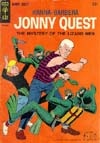 In 1964, Gold Key published a comicbook
adaptation of "The Mystery of the Lizard Men." The book reads like a still-frame
version of the episode, with many of the same scenes, and the art style is similar
to that of the show, although no artist is given credit in the book.
In 1964, Gold Key published a comicbook
adaptation of "The Mystery of the Lizard Men." The book reads like a still-frame
version of the episode, with many of the same scenes, and the art style is similar
to that of the show, although no artist is given credit in the book.
Jonny Quest [COMICO]
COMICO The Comic Company
1547 DeKalb St., Norristown, PA 19401
Between 1986 and 1988, Comico produced a set of 31 standard-issue Jonny Quest comics,
plus 2 "specials," and a very nice set of three "classic" issues. These books were
created with the approval of Hanna-Barbera, and storylines and character development
had to fit H-B's guidelines. After all, JQ was still a major success for H-B; around
this same time frame (1986), H-B was producing JQ's "second season," so they were
pretty involved with any projects involving the JQ license. As much as anything
else (outside the original TV episodes), these books can (IMHO) be considered "canon"
in the Jonny Quest universe. Nothing in these comics (to my knowledge) contradicts
anything shown in the episodes, and the characters develop in a manner consistent
with the original concepts.
These comics were decently promoted, and, on the whole, very well received, at least
at first, although a downturn in circulation eventually ended the series (as it
has for many, many others). The original plan was to produce 12 issues, but fortunately
this soon grew to:
- a 31-issue "regular" run
- 2 "special" issues
- a special 3-issue run of the "Jezebel Jade" title
- a very special set of 3 issues commemorating
three 1964 TV episodes, written and drawn by Doug Wildey himself!
The books were also nominated for the "Kirby" award for "Best New Comic". Below
are some links to articles about the series that appeared in several issues of Amazing Heroes, a magazine devoted to news
and reviews in the comic industry.
Below are scans of each issue's cover, with the technical details for each book,
and, of course, some personal comments. Click on the cover images or titles to see
larger images of the comic book covers.
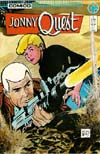 #1,
June 1986: The Sands of Khasa Tahid Part 1 "The Sands of Khasa Tahid":
Doug Wildey (writer, artist, inker, colorist, letterer, etc.) #1,
June 1986: The Sands of Khasa Tahid Part 1 "The Sands of Khasa Tahid":
Doug Wildey (writer, artist, inker, colorist, letterer, etc.)
Part 2 "City of Time Lost": William Messner-Loebs, writer; Steve Rude, artist; Mike
Royer, inker; Matt Wagner, colorist; Bob Pinaha, letterer; Diana Schutz, editor
This is the next-best thing to seeing a brand-new JQ episode -- a JQ comic drawn
by Doug Wildey! (Well, at least half of it was -- more on that later.) The cover,
also by Wildey (click on the image or title to see the complete image), is pure
vintage JQ, and while reading the first half of the book, one can almost hear the
character's voices and that wonderful Hoyt Curtin underscore. Wildey scores a coup,
here, by including nearly every character that appeared more than once in the classic
TV show in his story: Jonny, Hadji, Bandit, Race, and Dr. Quest, of course, but
also Jade and Dr. Zin (the only TV show repeat character not in this story is Mr.
Corbin, Race's boss at Intelligence-1). In doing so, he set the stage for the rest
of the books, and how they would be constructed. We couldn't have asked for a better
start!
The second half of the book picks up the tale started in the first half, and does
a creditable job, IMHO, although it does suffer by comparison to the Wildey lead-in.
The characters aren't drawn quite the same, although they're pretty good, and the
dialogue and atmosphere come very close to Wildey's standards. It's a shame Wildey
couldn't have done more for this series (he did do two more covers, as well as all
the work in re-creating three TV episodes in the "classics" series), but Comico
did a respectable job in trying to duplicate the feel of the original TV show.
Trivia:Wildey makes it official in this issue
-- Jade's nickname is "Jezebel." Although widely accepted among classic JQ fans,
this was never mentioned in the TV episodes. (She was always simply referred to
as "Jade.")
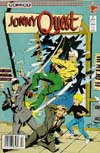 #2,
July 1986: Enter Race Bannon #2,
July 1986: Enter Race Bannon
William Messner-Loebs, writer; Wendy Pini, penciller; Joe Staton, inker;
Bob Pinaha, letterer; Rick Taylor, colorist; Diana Schutz, editor; Steve Rude, cover
We were never told, in the original TV series, what happened to Jonny's mom. All
we know is this: in the episode titled "Mystery of the Lizard Men" the intelligence
personnel charged with protecting Dr. Quest and Jonny mention that Jonny's mother
died. In "Jonny's Golden Quest," that movie's makers attempted to answer that question,
but in the opinion of many, handled it very poorly, involving Dr. Zin in her death.
Now, in issue #2, COMICO gives their version of what happened, and, at the same
time, tell how Race Bannon became assigned to the scientist and his son. Sensitively
told, with much affection for the characters, this second issue bodes well for the
series, even though the artwork is a little "flatter" than the Doug Wildey or Steve
Rude productions, but it still is quite decent, all the same. And the cover makes
nice use of a shadow to "mask" one character's appearance, so not too much is given
away.
Note:See the Classic JQ FAQ page's
entry on Jonny's mom for more on this subject.
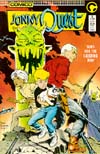 #3,
August 1986: Guns for the Laughing Man #3,
August 1986: Guns for the Laughing Man
William Messner-Loebs, writer; Mark Hempel, penciller, letterer; Mark
Wheatley, inker, colorist; Kathryn Mayer, letterer, colorist; Diana Schutz, editor;
Dave Stevens, front cover; Marc Hempel, Mark Wheatley, back cover
A decent yarn involving terrorists, a foreign locale, a mysterious local legend,
enemies who turn out to be friends, friends who turn out to be enemies, and lots
of action. The introduction of a new character, Wild Jim Cannon, a former colleague
of Race's, was done pretty well, reminiscient of Dr. Quest's scientist associates
we sometimes get to meet.
The artwork was a bit "fuller" in this issue compared to that in issue #2; more
richly-drawn with shadows and colors mixing well, and the dialogue was well-done,
too.
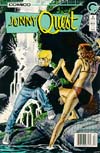 #4,
September 1986: Marley Frost is Here to Stay #4,
September 1986: Marley Frost is Here to Stay
William Messner-Loebs, story; Tom Yeates, pencils; Bob Pinaha, letters;
Dan Adkins, Bret Blevins, Sam Kieth, Steve Leialoha, Steve Rude, Dave Stevens, Al
Williamson, Tom Yeates, inks; Ken Feduniewicz, colors; Diana Schutz, edits; Tom
Yeates, Al Williamson, cover
This was an interesting issue - a bit of comedy, actually, which is not all that
common in the world of JQ. Oh, the mystery was present, and it did take place in
a remote location, so it was still recognizable JQ. And the artwork and layout was
very good -- rich, full, lots of textures, shadows, color, but not too busy or confusing.
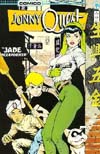 #5,
October 1986: Jade Incorporated #5,
October 1986: Jade Incorporated
William Messner-Loebs, chief executive officer; Mitch Schauer, president;
John Nyberg, vice-president; Steve Haynie, secretary; Rick Taylor, director of public
relations; Diana Schutz, chairman of the board; Dave Stevens, front cover; Mitch
Schauer (pencils), Bret Blevins (inks), Rick Taylor (colors), back cover
This issue "pushed the envelope" in several ways, some good, some not so. It was
good to have the focus on Jade (I personally think that this was a "trial" for the
limited 3-issue series Jezebel Jade that Comico would produce
in the future). And it was good to see both Jonny and Hadji hold their own in a
tale that required not only quick reflexes but quick thinking, as well. And, to
the best of my knowledge, this issue showed a face-to-face meeting with Dr. Zin
for the first time. And the Dave Stevens cover was excellent (although Jade never
looked like that in the TV episodes)! That was the good...
Now, for the not so good...Zin's "sky fortress" was WAY over the top; there's NO
WAY a monstrous ship like that can just be conveniently hovering in one place --
that thing was a battleship! And having a CAR fitted with rockets so it could rendezvous
with the fortress was too unbelievable. If they wanted Zin to be accessible in this
tale, they could have used more conventional travel means (helicopter, supersonic
jet, etc.) to get Jade and the boys to his earth-bound fortress instead. And having
Jonny fly the car off the fortress and maneuver it accurately enough to get them
safely back to earth was also a bit of a stretch. If these parts were removed, the
tale would be much improved. Finally, the artwork was a bit "flat" again; I sure
miss those striking shadows and textures of Wildey, Rude, and Stevens.
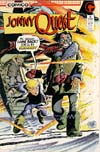 #6,
November 1986: Philosopher's Stone #6,
November 1986: Philosopher's Stone
William Messner-Loebs, story; Adam Kubert, art, letters, colors; Diana
Schutz, edits
In this continuation of the story in issue #5, there's more goodness and more...uh...not-goodness.
The artwork and dialogue were very good, with the one exception of the (seeming)
abundance of "sound effects" (Kawhooommmm! Kreeeeeeee!! and even Bar-Kashvrrroooom!
(Bar-Kashvrrroooom?)) -- we really don't need that in a JQ episode. Of course, Dr.
Zin and his fantastic flying fortress were back (ugh) and the government types were
too stereotypically bad (ugh, again), but the character of Quigley was developed
well.
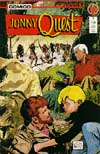 #7,
December 1986: The Lady in Gray #7,
December 1986: The Lady in Gray
William Messner-Loebs, story; Dan Spiegle, art; Carrie Spiegle, letters;
Tom Reilly, colors; Diana Schutz, edits; Doug Wildey, cover
Another Wildey cover (click on the image or title to see the complete, wrap-around
image)! And a decent story, and the artwork is pretty good, too. One just needs
to overlook the preponderance of all the high-tech gadgetry employed by Dr. Zin
(who looks a little melon-headed in this issue, if you ask me). OK, so it's not
just Zin, the Quest also use some pretty unbelievable gadgets, too. Those little
floating disks they zoom about on almost made me throw the book away in disgust!
(Only the Wildey cover saved it from such a fate.) However, I did like the story
and the premise of what it must feel like for someone unfamiliar with the way the
Quests work together to be dropped into the thick of things without a clue as to
what's going on. And, by the time issue #31 (the last issue) rolls around, we'll
see that the character of Kathy Martin, the social worker, will become much more...
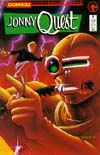 #8,
January 1987: The Curse of X-7 #8,
January 1987: The Curse of X-7
William Messner-Loebs, story; L. Lois Buhalis, letters; Diana Schutz,
edits; Ken Steacy, everything else, eh?
The story was an interesting one, and really held my interest through-out, but I
couldn't stand much more of the art -- it was so stylized and "modernized" with
edges and angles over-emphasized...well, to summarize, this is hopefully the last
time this look is authorized! And I really didn't appreciate the graphic images
of death on the back cover -- did we really need to see everyone but Jonny hanged
by the neck from ropes (even Bandit)?
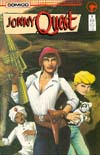 #9,
February 1987: A Fire in Green Meadows #9,
February 1987: A Fire in Green Meadows
William Messner-Loebs, writer; Bob Pinaha, letterer; Diana Schutz, editor;
Murphy Anderson, artist; Dan Zolnerowich, background assist; Murphy Anderson III,
colorist; Tim Truman, cover
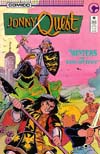 #10,
March 1987: Winters of Discontent #10,
March 1987: Winters of Discontent
William Messner-Loebs, writer; Marc Hempel, penciller/letterer; Mark
Wheatley, inker/colorist; Kathryn Mayer, letterer/colorist; Diana Schutz, editor;
Marc Hempel, Mark Wheatley, cover
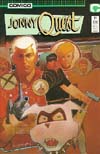 #11,
April 1987: Dog Days #11,
April 1987: Dog Days
William Messner-Loebs, writing; Joe Staton, pencilling; Rick Burchett,
inking; Bob Pinaha, lettering; Rick Taylor, cooring; Diana Schutz, editing; Bill
Sienkiewicz, cover
Hmm...a Bandit adventure? OK, I'll bite...just this once.
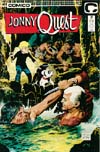 #12,
May 1987: Buried Treasure #12,
May 1987: Buried Treasure
William Messner-Loebs, writer; Dan Spiegle, artist; Carrie Spiegle, letterer;
Tom Reilly, colorist; Diana Schutz, editor; Doug Wildey, cover
Yes! Another wrap-around cover by Doug Wildey (click on the image or title to see
the complete, wrap-around image)!
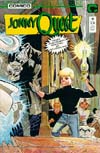 #13,
June 1987: Things That Go Bump in the Night #13,
June 1987: Things That Go Bump in the Night
William Messner-Loebs, writer; Carmine Infantino, artist; Adam Kubert,
colorist; Bob Pinaha, letterer; Diana Schutz, editor; Carmine Infantino, cover
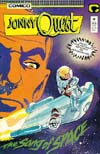 #14,
July 1987: The Song of Space #14,
July 1987: The Song of Space
William Messner-Loebs, story; Marc Hempel, pencils/letters; Mark Wheatley,
inks/colors; Kathryn Mayer, letters/colors; Diana Schutz, edits; Marc Hempel, Mark
Wheatley, cover
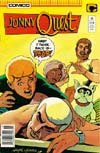 #15,
August 1987: The Sins of Zin - Part 1 #15,
August 1987: The Sins of Zin - Part 1
William Messner-Loebs, story; Marc Hempel, pencils & inks & letters;
Mark Wheatley, colors; Kathryn Mayer, letters & colors; Diana Schutz, confessor;
Marc Hempel, Mark Wheatley, cover
Zin's first name is Napoleon?
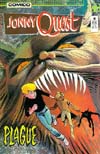 #16,
September 1987: Plague: The Sins of Zin - Part 2 #16,
September 1987: Plague: The Sins of Zin - Part 2
William Messner-Loebs, story; Marc Hempel, letters; Mark Wheatley, art/color;
Kathryn Mayer, letters/color; Diana Schutz, edits; Marc Hempel, Mark Wheatley, cover
Never did like lycanthropy stories; always seemed too contrived. Here's an example
of what I mean...
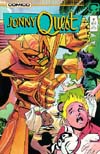 #17,
October 1987: Another Stuart Gold Production #17,
October 1987: Another Stuart Gold Production
William Messner-Loebs, direction; Marc Hempel, Mark Wheatley, Kathryn
Mayer, cinematography; Diana Schutz, gofer; Marc Hempel, Mark Wheatley, cover
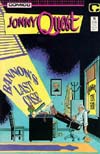 #18,
November 1987: Bannon's Last Case #18,
November 1987: Bannon's Last Case
William Messner-Loebs, script; Marc Hempel, Mark Wheatley, Kathryn Mayer,
art; Diana Schutz, edits; Marc Hempel, Mark Wheatley, cover
A 1940's-style detective yarn? OK, that explains the black-and-white...
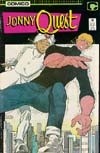 #19,
December 1987: Lesson One #19,
December 1987: Lesson One
William Messner-Loebs, story; Ernie Colon, artwork; Bob Pinaha, letters;
Kathryn Mayer, colors; Diana Schutz, report card; Ernie Colon, cover
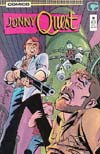 #20,
January 1988: Time Storm #20,
January 1988: Time Storm
Written by William Messner-Loebs, from an idea by Robert Morgan; Illustrated
by Marc Hempel, Mark Wheatley, and Kathryn Mayer; Edited by Diana Schutz; Marc Hempel,
Mark Wheatley, cover
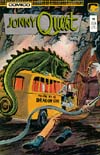 #21,
February 1988: Heer There be Dragons #21,
February 1988: Heer There be Dragons
William Messner-Loebs, story; Dan Spiegle, art; Carrie Speigle, letters;
Joe Matt, colors; Diana Schutz, edits; Dan Spiegle, cover
Refreshingly rich artwork; but depressingly bland story about Race's childhood.
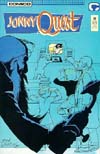 #22,
March 1988: Vantange Point #22,
March 1988: Vantange Point
William Messner-Loebs, writer; Marc Hempel, Mark Wheatley, Kathryn Mayer,
illustrators; Diana Schutz, editor; Mark Wheatley, cover
A glimpse of what it's REALLY like around Palm Key on a daily basis...
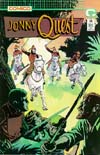 #23,
April 1988: The Prisoner of Starkgrau - Part 1 #23,
April 1988: The Prisoner of Starkgrau - Part 1
William Messner-Loebs, story; Marc Hempel, pencils/letters; Mark Wheatley,
pencils/inks/colors; Kathryn Mayer, letters/colors; Diana Schutz, jailer; Marc Hempel,
cover
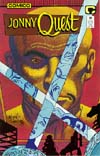 #24,
May 1988: Crossed Swords: The Prisoner of Starkgrau - Part 2 #24,
May 1988: Crossed Swords: The Prisoner of Starkgrau - Part 2
William Messner-Loebs, writer; Marc Hempel, Mark Wheatley, Kathryn Mayer,
artists; Diana Schutz, editor; Marc Hempel, Mark Wheatley, cover
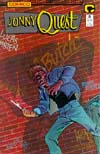 #25,
June 1988: Butch #25,
June 1988: Butch
William Messner-Loebs, story; Marc Hempel, pencils/letters; Mark Wheatley,
inks/colors; Kathryn Mayer, letters/colors; Diana Schutz, edits; Marc Hempel, Mark
Wheatley, cover
Another Bandit story? Oh, well, better than another Race story...but not by much.
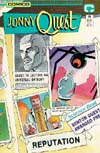 #26,
July 1988: Reputation #26,
July 1988: Reputation
William Messner-Loebs, story; Marc Hempel, pencils/letters; Mark Wheatley,
inks/colors; Kathryn Mayer, letters/colors; Diana Schutz, gossip; Marc Hempel, Mark
Wheatley, cover
A fairly interesting concept, with a fair amount of character info...but, some of
the flashbacks showing scenes from previous adventures (and the well-known classic
TV adventures, at that) are just plain WRONG! If you are going to use some very
familiar images in your tale, better at least portray them accurately!
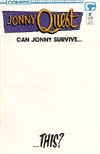 #27,
August 1988: Wilderness #27,
August 1988: Wilderness
William Messner-Loebs, story; Marc Hempel, Mark Wheatley, Kathryn Mayer,
illustrators; Diana Schutz, Canadian; with thanks to B.A. Richardson; Marc Hempel,
Mark Wheatley, cover
At last! A story focusing on Jonny! It is "Jonny Quest," after all, and after Bandit
had his second episode, I was wondering if Jonny would ever get his chance. Well,
he does, in this fine tale of a young man using his wits and courage to survive...
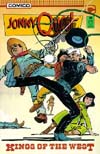 #28,
September 1988: Kings of the West - Part 1 #28,
September 1988: Kings of the West - Part 1
William Messner-Loebs, writer; Marc Hempel, penciller/letterer; Mark
Wheatley, penciller/inker/colorist; Kathryn Mayer, letterer/colorist; Diana Schutz,
editor; Marc Hempel, Mark Wheatley, cover
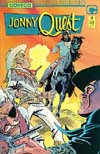 #29,
October 1988: Kings of the West - Part 2 #29,
October 1988: Kings of the West - Part 2
William Messner-Loebs, story; Marc Hempel, Mark Wheatley, Kathryn Mayer,
illustrators; Diana Schutz, editor; Marc Hempel, Mark Wheatley, cover
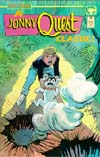 #30,
November 1988: The Invisible Monster (A Jonny Quest Classic!) #30,
November 1988: The Invisible Monster (A Jonny Quest Classic!)
Teleplay adaption: William Messner-Loebs; Art: Marc Hempel, Mark Wheatley,
and Kathryn Mayer; Memories: Diana Schutz
This retelling of the classic television episode does well in that it keeps a lot
of the same dialogue and images from the show. The artwork maintains its usual adequate,
if a bit flat, quality, but...one wonders (dreams, actually) of what this could
have been if drawn by the master, Doug Wildey! With a new intro and trailer surrounding
the episode proper, this issue was enjoyable and refreshing after some of the more
"off the wall" stories in previous issues. This is what Jonny Quest was, and should
be, all about!
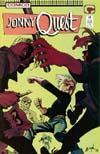 #31,
December 1988: Social Work #31,
December 1988: Social Work
William Messner-Loebs, writer; Marc Hempel, pencils/letters; Mark Wheatley,
inks/colors; Kathryn Mayer, letters/colors; Diana Schutz, editor; Marc Hempel, Mark
Wheatley, cover
Jonny Quest Special [COMICO]
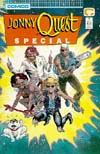 Special
#1, September 1988: Three Trapped Tigers Special
#1, September 1988: Three Trapped Tigers
Arthur Byron Cover, writer; Richard Howell, penciller; Jim Mooney, inker;
Tom Addis, letterer; Insight Studios, coloring; Diana Schutz, editor; Richard Howell,
cover
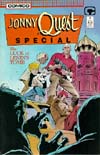 Special
#2, October 1988: The Luck of Lenin's Tomb Special
#2, October 1988: The Luck of Lenin's Tomb
Arthur Byron Cover, writer; John Hebert, penciller; Bill Anderson, inker;
Ken Holewczynski, letterer; Mark Wheatley, colorist; Mark Glidden, colorist; Michael
Eury, editor; Dave Stevens (?), cover
Jonny Quest Classics (Three-Issue Collector's Series) [COMICO]
Click on the images or titles to see the full wrap-around covers by Doug Wildey.
Also, you can follow this link to
go to a page where you can view much larger versions of these images and several
others, or download archives of the images for printing your own "mini-posters"
of these wonderful comic book covers.
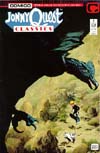 Classics
#1, May 1987: Shadow of the Condor Classics
#1, May 1987: Shadow of the Condor
Doug Wildey (writer, artist, inker, colorist, letterer, etc.)
Some scans of the original artwork for
this comic book's cover by Doug Wildey sent in by the owner, Patrick Jackson. The
piece is 18 x 23 1/2 inches. An awesome collectible,
Patrick, thanks for sharing it with us!
Aside from the thrill of seeing Wildey's recapturing of a classic JQ television
episode, in the back is part one of a three-part interview with Doug Wildey, in
which he talks about the episode in detail, why it is his favorite of all the JQ
episodes, why they were careful with Dr. Zin, and more.
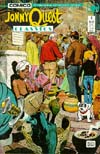 Classics
#2, June 1987: Calcutta Adventure Classics
#2, June 1987: Calcutta Adventure
Doug Wildey (writer, artist, inker, colorist, letterer, etc.)
The story of Hadji joining Jonny Quest's family as told by the man behind the vision.
Some of the elements have changed, and IMHO the tale is the better for it. Wildey's
attention to detail, to have it, above all, make sense, is a great asset and one
forgives easily for changing the images a bit here and there. After all, they are
his images. Part two of the Comico-Wildey interview adds more details and lets us
take a peek into what goes on "behind the scenes."
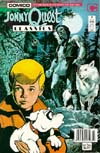 Classics
#3, July 1987: Werewolf of the Timberland Classics
#3, July 1987: Werewolf of the Timberland
Doug Wildey (writer, artist, inker, colorist, letterer, etc.)
It's a shame Wildey didn't adapt ALL of the JQ television episodes into comic book
form...in this final "classics" installment, we travel to the Canadian wilderness
in another fine offering. And in part three of the interview with Doug Wildey, we
learn about JQ's television character voice actors, a bit about Wildey's fascination
with the wild west, and even about how Jonny got his hair!
Jezebel Jade
In 1988, Comico produced a short (3-issue) series titled "Jezebel Jade" which
told how this lady of intrigue first met Race Bannon. The tale unfolds as Jonny
and Hadji are relegated to house-cleaning duties, and come across a manuscript buried
in the back of Race's closet, and apparently written by Race more than 10 years
ago. Eager to shirk their chores for a more exciting experience (who can blame them?),
the boys delve into the pages, and are soon caught up in the story.
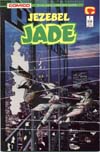
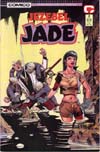
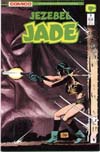
|